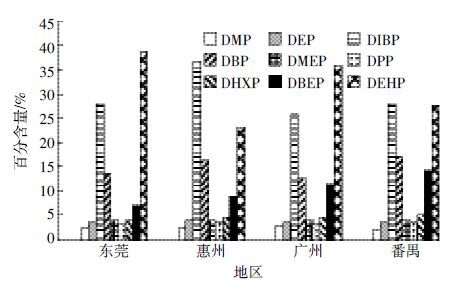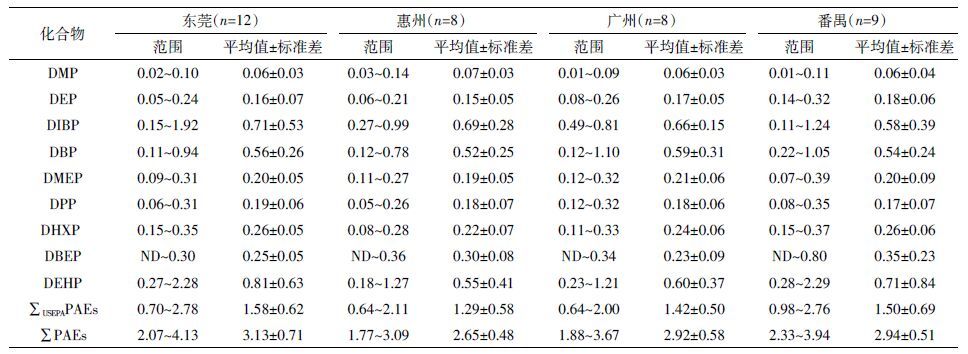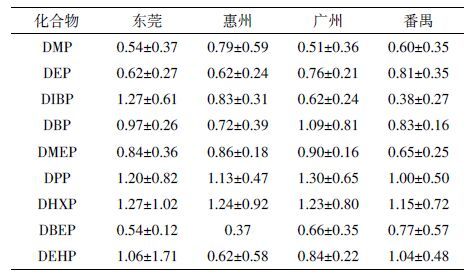文章信息
- 鲁磊安, 陈学斌, 赵海明, 莫测辉, 李慧, 李彦文, 蔡全英
- LU Lei-an, CHEN Xue-bin, ZHAO Hai-ming, MO Ce-hui, LI Hui, LI Yan-wen, CAI Quan-ying
- 珠三角地区稻田土壤和谷粒中邻苯二甲酸酯(PAEs)的分布特征及人体健康暴露风险
- Distribution of phthalic acid esters (PAEs) in paddy soil and grains of rice in the Pearl River Delta region and the health risk assessment
- 农业环境科学学报, 2016, 35(7): 1242-1248
- Journal of Agro-Environment Science, 2016, 35(7): 1242-1248
- http://dx.doi.org/10.11654/jaes.2016.07.003
文章历史
- 收稿日期: 2016-03-10
2. 暨南大学生态学系, 广州 510632
2. Department of Ecology, Jinan University, Guangzhou 510632, China
邻苯二甲酸酯(Phthalate esters,PAEs,俗称酞酸酯)是一类被广泛用作塑料增塑剂、农药载体等的人工合成有机物,其在塑料中含量可达40%~60%[1]。自2008 年以来,我国农用塑料薄膜每年的使用量均在200 万t 以上,2014 年达258 万t(地膜使用量为144万t)[2],地膜回收率为80.3%[3],导致大量PAEs 残留。PAEs能够在环境中长期残留、具有生物累积效应和毒性效应,是一类典型的环境内分泌干扰物,部分化合物具有潜在“三致”毒性,美国环保局(USEPA)将6种PAEs化合物[包括邻苯二甲酸二甲酯DMP、邻苯二甲酸二乙酯DEP、邻苯二甲酸正二丁酯DBP、邻苯二甲酸丁基苄基酯BBP、邻苯二甲酸正二辛酯DOP、邻苯二甲酸双(2-乙基己基)酯DEHP]列为“优控污染物”。因此,农田环境PAEs污染越来越受到关注[4-7]。
近些年,我国学者对不同区域、不同土地利用类型等的土壤中PAEs 污染特征进行了广泛调查,发现部分土壤(每千克)的PAEs 含量高达几百甚至上千毫克,一些地区每千克农业土壤中PAEs 的含量也高达几十毫克,超过了美国纽约州土壤PAEs 的治理标准(DMP、DEP、DBP、DEHP 分别为0.02、0.071、0.081、4.35 mg·kg-1)[5-7, 8-11]。例如,南疆棉田土壤中6 种PAEs(包括4 种美国环保局优先控制污染物)的总含量为123.9~1232 mg·kg-1 [8]。广东省农业土壤中6 种优控PAEs的总含量(Σ6PAEs)在ND(未检出)~26 mg·kg-1之间,高低次序为水田>香蕉地>菜地>甘蔗地>果园地[4]。广州和深圳蔬菜生产基地土壤中的Σ6PAEs为3.0~45.7 mg·kg-1,DBP 和DEHP 分别为ND~20.6mg·kg-1 和2.85~25.1 mg·kg-1[12]。农田土壤PAEs 污染值得关注。
土壤中PAEs会影响植物生长和土壤微生物群落结构与功能[13-15],并有一定的生物累积效应[13, 16]。例如,水稻和菜心等植物可以从土壤中吸收累积PAEs[13, 16]。李彬等[17]发现珠三角地区农产品中Σ6PAEs 为ND~79.9 mg·kg-1,平均为2.84 mg·kg-1,各类农产品中平均Σ6PAEs的高低顺序为蔬菜>水稻>水果。目前,国内外对蔬菜生产基地尤其是大棚栽培的土壤和蔬菜中PAEs 污染特征进行了一定调查[5-7, 12],但对水稻种植区土壤和水稻谷粒中PAEs 含量水平的研究鲜有报道。有研究发现,美国纽约州各类食品均可检测到PAEs,以谷类的DBP 和DEHP 含量较高,平均为15.90 μg·kg-1和61.60 μg·kg-1[18]。谷类食品是我国人体每日摄入DEHP 的主要来源,占总摄入量的39.44%~44.57%[19]。因此,本研究选择珠江三角洲代表性水稻种植区,采集土壤和水稻谷粒样品,采用超声提取与GC-MS 测定9 种PAEs 化合物,研究不同区域稻田土壤及水稻谷粒中PAEs 含量分布及生物累积效应,并评价人体健康暴露风险,为保障粮食质量安全和有效控制土壤PAEs污染提供科学依据。
1 材料与方法 1.1 样品采集根据广东省不同区域水稻的种植面积、种植历史、品种类型、农田布局和周围的环境等,选择珠三角4 个典型的水稻种植区进行多点采样,包括东莞、惠州(龙门)、广州和番禺。样品于水稻收割期采集,同一田块随机多点采样,混合均匀为1 个样品。同一样点采集土壤、水稻谷粒,每个样品采集3 kg 左右。共采集稻田土壤样品30 个,谷粒样品37 个。采集的样品当天送到实验室后,土壤自然风干、研磨过筛,4 ℃保存备用。水稻谷粒分大米和谷壳,用不锈钢粉碎机粉碎成粉末。
1.2 样品前处理所用有机溶剂均为色谱纯。实验过程未使用任何塑料制品,玻璃仪器经重铬酸钾洗液浸泡,蒸馏水洗涤后烘干备用。玻璃仪器使用前采用相应有机溶剂润洗。土壤和谷物等样品采用二氯甲烷颐丙酮(3:1,V/V)混合液进行超声提取,方法参考USEPA 3500b[16, 20]。准确称量粉碎后的样品0.50 g于50 mL 玻璃离心管中,加入20 mL 混合溶剂超声提取10 min(重复3次),于1037 g下离心分离。提取液采用硅胶柱净化,旋转蒸发仪(亚荣RE-52A,上海)浓缩后,转移至棕色进样瓶,氮吹后定容至1 mL,4 ℃保存待测[13]。
1.3 GC-MS 分析待测液中的PAEs 采用GC-MS 分析,参考USEPA8270C 方法[20]。GC-MS 联用仪型号为GCMSQP2010(岛津,日本),色谱柱为DB-5MS 石英毛细管柱(30 m×0.25 mm×0.25 μm),载气为高纯氦气(He)。质谱仪所用离子源为电子轰击源(EI)。不分流进样,进样口温度250 ℃,进样量1 μL,柱流量0.80mL·min-1,检测器温度280 ℃。离子源温度为220 ℃,接口温度为250 ℃。柱温箱程序升温:初始温度60 ℃,保持1 min,以35 ℃·min-1 升到110 ℃,以8 ℃·min-1升到200 ℃,以5 ℃·min-1升到280 ℃,溶剂延迟时间5.00 min,运行时间41.00 min。采用全扫描检测,根据质谱特征离子及相对保留时间对样品定性。分析的PAEs 包括9 种化合物:DMP、DEP、DBP、DEHP、邻苯二甲酸二异丁酯(DIBP)、邻苯二甲酸二(2-甲氧基)乙酯(DMEP)、邻苯二甲酸二戊酯(DPP)、邻苯二甲酸二己酯(DHXP)、邻苯二甲酸二(2-丁氧基)乙酯(DBEP)。标准溶液购自美国ULTRA Scientific 公司(North Kingstown,RI.)。采用9 种PAEs化合物混合标样配制工作曲线,浓度为0.10、0.20、0.50、1.00、2.00、4.00、10.00 mg·L-1。利用上述建立的检测方法,对PAEs化合物的空白加标样进行了回收率测定。PAEs化合物的空白加标回收率为77.62%~88.94%,方法检出限为0.002~0.05 mg·kg-1。
2 结果与讨论 2.1 水稻田土壤中PAEs的含量分布本研究的珠三角地区水稻田土壤中PAEs 的含量分布见表 1。结果显示,除DBEP外(56.67%),其他PAEs化合物的检出率均为100%。9 种PAEs 化合物总含量(ΣPAEs)为2.93~8.05 mg·kg-1,平均为5.25mg·kg-1。不同采样区平均ΣPAEs的高低顺序为东莞(6.26 mg·kg-1)>番禺(5.29 mg·kg-1)>广州(4.80 mg·kg-1)>惠州(4.55 mg·kg-1)。珠三角地区稻田土壤中平均ΣPAEs 比同区域蔬菜基地土壤的低(3.00~45.7mg·kg-1)[12],但比广东省典型区域的农业土壤(平均ΣPAEs 为0.67 mg·kg-1)[4]和全国农业土壤(平均为3.43 mg·kg-1)[11, 21]的高。东莞、惠州稻田土壤中ΣPAEs均高于其相应城市土壤ΣPAEs含量(平均为3.71 mg·kg-1和0.60 mg·kg-1)[22]。这可能与农田大量施用农药和化肥以及工业“三废”污染有关。据《关于“农村环境污染治理”的调研报告》显示,广东省化肥施用强度高达852.4 kg·hm-2,是发达国家警戒线的3.8 倍;农药使用量达40.3 kg·hm-2,是发达国家对应限值的5.75倍[23]。广东省的常用化肥中可检测到PAEs 化合物[1],PAEs也被用作农药的乳化剂等。大量施用化肥和农药,可能导致土壤PAEs 残留增加。珠三角地区经济发展迅速,东莞工业区密集,其土壤受污染程度较其他城市严重[22]。

|
单个化合物中,以DEHP、DIBP 和DBP 含量较高,分别占ΣPAEs 的5.66%~61.7%、13.0%~51.0%和8.05%~26.6%(表 1 和图 1)(单个化合物百分含量为单个PAE 化合物含量与ΣPAEs 之比);其余6 种化合物的含量相对较低(小于1.00 mg·kg-1 甚至0.50mg·kg-1),共占ΣPAEs 的15%左右。然而,与美国纽约州的控制标准和治理标准[11]相比,本研究的稻田土壤中DMP、DEP、DBP含量均超标。

|
| 图 1 珠三角地区水稻田土壤中单个PAEs化合物占ΣPAEs 的百分含量 Figure 1 The percentage of individual PAE compounds in paddy soils in the Pearl River Delta region |
所采集的水稻谷粒样品中PAEs含量见表 2。谷粒ΣPAEs 为1.88~4.13 mg·kg-1(平均为2.93 mg·kg-1),以东莞的最高(平均为3.13 mg·kg-1),惠州的最低(平均为2.65 mg·kg-1)。与其他研究相比,本研究谷粒中优控PAEs 的含量水平(平均值1.46 mg·kg-1)比珠三角(采样区域包括中山、珠海、惠州和东莞4市)农产品(包括水稻、蔬菜、水果)中水稻(平均值2.52 mg·kg-1)的低[17],也低于相同区域典型蔬菜生产基地蔬菜中撞PAEs 水平(平均为3.20 mg·kg-1)[24]。为评价人体膳食摄入风险,同时测定了大米(本文测定的是糙米)和谷壳中PAEs 含量(表 3),其ΣPAEs 分别为1.32~3.22mg·kg-1( 平均为2.17mg·kg-1)和0.81~2.61mg·kg-1( 平均为1.43 mg·kg-1),说明PAEs更易累积于稻米中。

|

|
与土壤中PAEs 相似,谷粒中9 种化合物含量均以DEHP、DIBP 和DBP为主(表 2)。这与珠三角农产品中的优势PAEs 化合物(以DBP、DEHP 和DOP 为主)[17]存在一定差异。这可能与不同作物使用薄膜、施用化肥和农药等差异有关,也与大气中PAEs 的干湿沉降和植物从大气中吸收有关。有研究发现,广州室内外灰尘中16 种PAEs 总含量为121~3223 mg·kg-1(平均为840 mg·kg-1),以DBP、DIBP、DEHP 为主(累计占总量的93%以上)[25]。植物可以吸收从土壤中挥发出来的DBP和DEHP[26]。
植物可以从土壤中吸收PAEs 并向地上部运移,地上部PAEs 含量与其在土壤中含量有一定的关系[13, 16, 25]。可以采用生物富集系数(BCF)反映PAEs在植物体内的累积程度,它等于某一生物体内污染物的平衡浓度与其生存环境中该污染物浓度的比值[13]。本文的BCF 为水稻谷粒中PAEs 含量与土壤的比值(从空气中吸收/吸附的PAEs忽略不计)。水稻谷粒对PAEs的BCF见表 4。

|
水稻谷粒对PAEs化合物的BCF 在0.37~1.27 之间,其中DMP、DEP、DMEP、DBEP 的BCF 小于1,但部分DIBP、DBP、DPP、DHXP、DEHP 的BCF 大于1,说明水稻谷粒对不同化合物的吸收累积存在差异。与菜心和其他蔬菜对DBP 和DEHP 的BCF 相比[13, 24],水稻对PAEs的BCF明显高于蔬菜[24, 27]。田间水稻谷粒中PAEs 含量和BCF 与PAEs 理化性质有关,还与不同品种水稻的吸收迁移能力和周围大气环境的PAEs浓度相关。研究发现,不同品种水稻对DEHP的吸收累积存在显著差异[16];且植物体内DBP 和DEHP的含量与土壤污染浓度呈正相关关系[28]。还有研究发现,水稻叶片(包括剑叶)吸收累积的污染物(如镉)会向谷粒迁移[29]。因此,水稻植物体可能会从土壤中吸收累积PAEs 并向谷粒迁移,其对农产品质量安全的影响值得关注。
2.3 人体食用稻米对PAEs的健康暴露风险水稻是广东省的主要粮食作物,占90%以上的粮食种植面积和产量[2]。大米是广东省居民的主粮,有调查显示,广东成人日均食用米类218 g[30]。大米中PAEs 水平高低直接关系到食用人群的健康暴露水平。本研究采用日人均暴露量及参考剂量来评价人体健康暴露水平。
日人均暴露量(DI)= 大米中污染物浓度伊日均大米食用量/平均体重根据表 2 中DBP 和DEHP 的浓度,成人按每天食用大米218 g[30],平均体重60 kg;儿童(2~12 岁)按每天食用大米198 g[30-31],平均体重25.5 kg[31],分别计算成人和儿童食用这些大米的人体健康暴露水平,结果见表 5。

|
由于DBP 和DEHP 在环境中频繁检出且含量较高,目前美国环保局规定了这两种化合物的人体摄入参考剂量(RfD):DBP和DEHP分别为100 μg·kg-1 bw·d-1和20 μg·kg-1 bw·d-1[32]。由表 5 可知,成人和儿童食用大米对DBP 和DEHP 的日均摄入量均小于10μg·kg-1bw·d-1,儿童的暴露量高于成人。广东居民对DEHP的平均暴露水平(3.48 μg·kg-1 bw·d-1)高于全国人均暴露水平(2.34 μg·kg-1 bw·d-1)[19]。
采用风险商(即日人均暴露量DI/参考剂量RfD)对水稻谷粒DBP 和DEHP 的健康风险进行评价,将估算的暴露量与其参考剂量进行比较,若其值小于1,认为PAEs 健康暴露风险可以接受,反之则认为存在PAEs健康暴露风险。根据表 5 结果和美国环保局推荐的参考剂量,DBP 和DEHP 的风险均在可接受范围内,健康暴露风险水平较低。但目前国内外还没有其他食品相关的PAEs含量控制标准。本研究中只考虑食用大米的健康暴露水平。若同时考虑食用蔬菜、肉类等食品及饮用水的暴露量,对食用大米的长期低剂量摄入也不容忽视。
3 结论珠三角4 个水稻种植区的土壤和水稻谷粒中PAEs均以DIBP、DEHP 和DBP为主,稻田土壤和水稻谷粒中ΣPAEs 分别为3.25~8.05 mg·kg-1 和1.77~4.13 mg·kg-1,两者均以东莞的平均值最高。水稻谷粒对PAEs 的生物富集系数在0.37~1.27 之间,对不同PAEs化合物的吸收累积存在差异。广东居民食用本研究区稻米对DBP和DEHP 的健康暴露水平低于美国环保局推荐的参考剂量,健康暴露风险水平较低。但稻田土壤PAEs 污染及其在谷粒中的累积需要引起关注。
| [1] | Mo C H, Cai Q Y, Zeng Q Y. Occurrence of priority organic pollutants in the fertilizers, China[J]. Journal of Hazardous Materials , 2008, 152 (3) : 1208–1213. |
| [2] | 国家统计局农村社会经济调查司. 中国农村统计年鉴[M]. 北京: 中国统计出版社, 2015 . Department of Rural Surveys of National Bureau of Statistics. China rural statistical yearbook[M]. Beijing: China Statistics Press, 2015 . |
| [3] | 中国环境保护部, 中国国家统计局, 中国农业部. 第一次全国污染源普查公报[R]. 2010. The Environmental Protection Department of China, the National Statis tics Bureau of China, Ministry of Agriculture. The first national census of pollution sources[R]. 2010. |
| [4] | 杨国义, 张天彬, 高淑涛, 等. 广东省典型区域农业土壤中邻苯二甲酸酯含量的分布特征[J]. 应用生态学报 , 2007, 18 (10) : 2308–2312. YANG Guo-yi, ZHANG Tian-bin, GAO Shu-tao, et al. Distribution of phthalic acid esters in agricultural soils in typical regions of Guangdong Province[J]. Chinese Journal of Applied Ecology , 2007, 18 (10) : 2308–2312. |
| [5] | Cai Q Y, Mo C H, Wu Q T, et al. The status of soil contamination by semivolatile organic chemicals(SVOCs)in China:A review[J]. Science of the Total Environment , 2008, 389 (2/3) : 209–224. |
| [6] | Wang J, Luo Y M, Teng Y, et al. Soil contamination by phthalate esters in Chinese intensive vegetable production systems with different modes of use of plastic film[J]. Environmental Pollution , 2013, 180 : 265–273. |
| [7] | Sun J, Pan L, Zhan Y, et al. Contamination of phthalate esters, organochlorine pesticides and polybrominated diphenyl ethers in agri cultural soils from the Yangtze River Delta of China[J]. Science of the Total Environment , 2016, 544 : 670–676. |
| [8] | 郭冬梅, 吴瑛. 南疆棉田土壤中邻苯二甲酸酯(PAEs)的测定[J]. 干旱环境监测 , 2011, 25 (2) : 76–79. GUO Dong-mei, WU Ying. Determination of phthalic acid esters of soil in South of Xinjiang cotton fields[J]. Arid Environmental Monitoring , 2011, 25 (2) : 76–79. |
| [9] | Zeng F, Cui K, Xie Z, et al. Distribution of phthalate esters in urban soils of subtropical city, Guangzhou, China[J]. Journal of Hazardous Materials , 2009, 164 (2/3) : 1171–1178. |
| [10] | Wang X, Lin Q X, Wang J, et al. Effect of wetland reclamation and tillage conversion on accumulation and distribution of phthalate esters residues in soils[J]. Ecological Engineering , 2013, 51 : 10–15. |
| [11] | Niu L, Xu Y, Xu C, et al. Status of phthalate esters contamination in a gricultural soils across China and associated health risks[J]. Environ mental Pollution , 2014, 195 : 16–23. |
| [12] | 蔡全英, 莫测辉, 李云辉, 等. 广州、深圳地区蔬菜生产基地土壤中邻苯二甲酸酯(PAEs)研究[J]. 生态学报 , 2005, 25 (2) : 284–287. CAI Quan-ying, MO Ce-hui, LI Yun-hui, et al. The study of PAEs in soils from typical vegetable fields in areas of Guangzhou and Shenzhen, South China[J]. Acta Ecologica Sinica , 2005, 25 (2) : 284–287. |
| [13] | Zhao H M, Du H, Xiang L, et al. Variations in phthalate ester(PAE) accumulation and their formation mechanism in Chinese flowering cabbage (Brassica parachinensis L[J]. Environmental Pollution , 2015, 206 : 95–103. |
| [14] | Wang Z G, Liu S, Xu W H, et al. The microbiome and functions of black soils are altered by dibutyl phthalate contamination[J]. Applied Soil Ecology , 2016, 99 : 51–61. |
| [15] | Wang Z G, Liu S, Xu W H, et al. Impacts of dimethyl phthalate on the bacterial community and functions in black soils[J]. Front Micro biol , 2015, 6 : 1–11. |
| [16] | Cai Q Y, Xiao P Y, Chen T, et al. Genotypic variation in the uptake, accumulation, and translocation of di-(2-ethylhexyl)phthalate by twenty cultivars of rice(Oryza sativa L[J]. Ecotoxicology and Environmental Safety , 2015, 116 : 50–58. |
| [17] | 李彬, 吴山, 杨国义, 等. 珠江三角洲典型区域农产品中邻苯二甲酸酯污染特征分布[J]. 环境科学 , 2016, 37 (1) : 317–324. LI Bin, WU Shan, YANG Guo-yi, et al. Distribution characteristics and risk assessment of phthalic acid esters in agricultural products Around the Pearl River Delta, South China[J]. Environmental Science , 2016, 37 (1) : 317–324. |
| [18] | Schecter A, Lorber M, Guo Y, et al. Phthalate concentrations and di etary exposure from food purchased in New York State[J]. Environ mental Health Perspectives , 2013, 121 (4) : 473–479. |
| [19] | Sui H X, Zhang L, Wu P G, et al. Concentration of di(2-ethylhexyl) phthalate(DEHP)in foods and its dietary exposure in China[J]. Inter national Journal Hygiene and Environmental Health , 2014, 217 (6) : 695–701. |
| [20] | USEPA. Method 8270C Semivolatile organic compounds by gas chromatography-mass spectrometry (GC/MS)[S]. Revision 3ed. United States Environmental Protection Agency, 1996. |
| [21] | Hu X Y, Wen B, Shan X Q. Survey of phthalates pollution in arable soils in China[J]. Journal of Environmental Monitoring , 2003 (5) : 649–653. |
| [22] | 赵胜利, 杨国义, 张天彬, 等. 塑料增塑剂(邻苯二甲酸酯)对珠三角城市群典型中小城市土壤的污染研究[J]. 农业环境科学学报 , 2009, 28 (6) : 1147–1152. ZHAO Sheng-li, YANG Guo-yi, ZHANG Tian-bin, et al. Study on plasticizer(phthalic acid esters, PAEs)pollution in soils from typical cities in Pearl River Delta[J]. Journal of Agro-Environment Science , 2009, 28 (6) : 1147–1152. |
| [23] | 徐林, 雷辉. 农村环境污染咋治省政协常委会开方[N]. 南方日报, 2013-09-26. XU Lin, LEI Hui. Rural environmental pollution, Guangdong Standing Committee of CPPCC suggested how to treat[N]. Nanfang Daily, 2013-09-26. |
| [24] | Mo C H, Cai Q Y, Tang S R, et al. Polycyclic aromatic hydrocarbons (PAHs)and phthalic acid esters (PAEs)in vegetables from nine farms of the Pearl River Delta, South China[J]. Archives of Environment Con tamination and Toxicology , 2009, 56 (2) : 181–189. |
| [25] | Lan Q, Cui K Y, Zeng F, et al. Characteristics and assessment of phtha late esters in urban dusts in Guangzhou City, China[J]. Environmental Mo nitoring and Assessment , 2012, 184 (8) : 4921–4929. |
| [26] | 曾巧云, 莫测辉, 蔡全英, 等. 萝卜对邻苯二甲酸酯(PAEs)吸收累积特征及途径的初步研究[J]. 环境科学学报 , 2006, 26 (1) : 10–16. ZENG Qiao-yun, MO Ce-hui, CAI Quan-ying, et al. Possible pathways through which phthalic acid esters(PAEs)are accumulated in radish plants(Raphnus Sativus)[J]. Acta Scientiae Circumstaniae , 2006, 26 (1) : 10–16. |
| [27] | Cai Q Y, Mo CH, Zeng Q Y, et al. Potential of Ipomoea aquatic cultivars in phytoremediation of soils contaminated with di-n-butyl phtha late[J]. Environmental and Experimental Botany , 2008, 62 (3) : 205–211. |
| [28] | 宋广宇, 代静玉, 胡锋. 邻苯二甲酸酯在不同类型土壤-植物系统中的累积特征研究[J]. 农业环境科学学报 , 2010, 29 (8) : 1502–1508. SONG Guang-yu, DAI Jing-yu, HU Feng. Accumulation of phthalic acid esters in different types of soil-plant systems[J]. Journal of AgroEnvironment Science , 2010, 29 (8) : 1502–1508. |
| [29] | Fujimaki S, Suzui N, Ishioka N S, et al. Tracing cadmium from culture to spikelet:Noninvasive imaging and quantitative characterization of absorption, transport, and accumulation of cadmium in an intact rice plant[J]. Plant Physiology , 2010, 152 (4) : 2006–2014. |
| [30] | 唐洪磊, 郭英, 曾永平, 等. 广东省沿海城市居民膳食结构及食物污染状况的调研:对持久性卤代烃和重金属的人体暴露水平评价[J]. 农业环境科学学报 , 2009, 28 (2) : 329–336. TANG Hong-lei, GUO Ying, ZENG Yong-ping, et al. Nutritional status in dietary intake and pollutants via food in coastal cities of Guangdong Province, China:Assessment of human exposure to persistent halo genated hydrocarbons and heavy metals[J]. Journal of Agro-Environment Science , 2009, 28 (2) : 329–336. |
| [31] | 周少君, 邓小玲, 梁辉, 等. 2012年广东省市售大米镉含量调查及初步膳食暴露评估[J]. 华南预防医学 , 2013, 39 (6) : 4–7. ZHOU Shao-jun, DENG Xiao-ling, LIANG Hui, et al. Cadmium con tamination and dietary exposure assessment in retailed rice in Guang dong Province, 2012[J]. South China J Prev Med , 2013, 39 (6) : 4–7. |
| [32] | Yuan K, Bon M Y, Kwai Chung C, et al. Risk assessment of human ex posure to bioaccessible phthalate esters via indoor dust around the Pearl River Delta[J]. Environmental Science and Technology , 2012, 46 (15) : 8422–8430. |
 2016, Vol. 35
2016, Vol. 35




